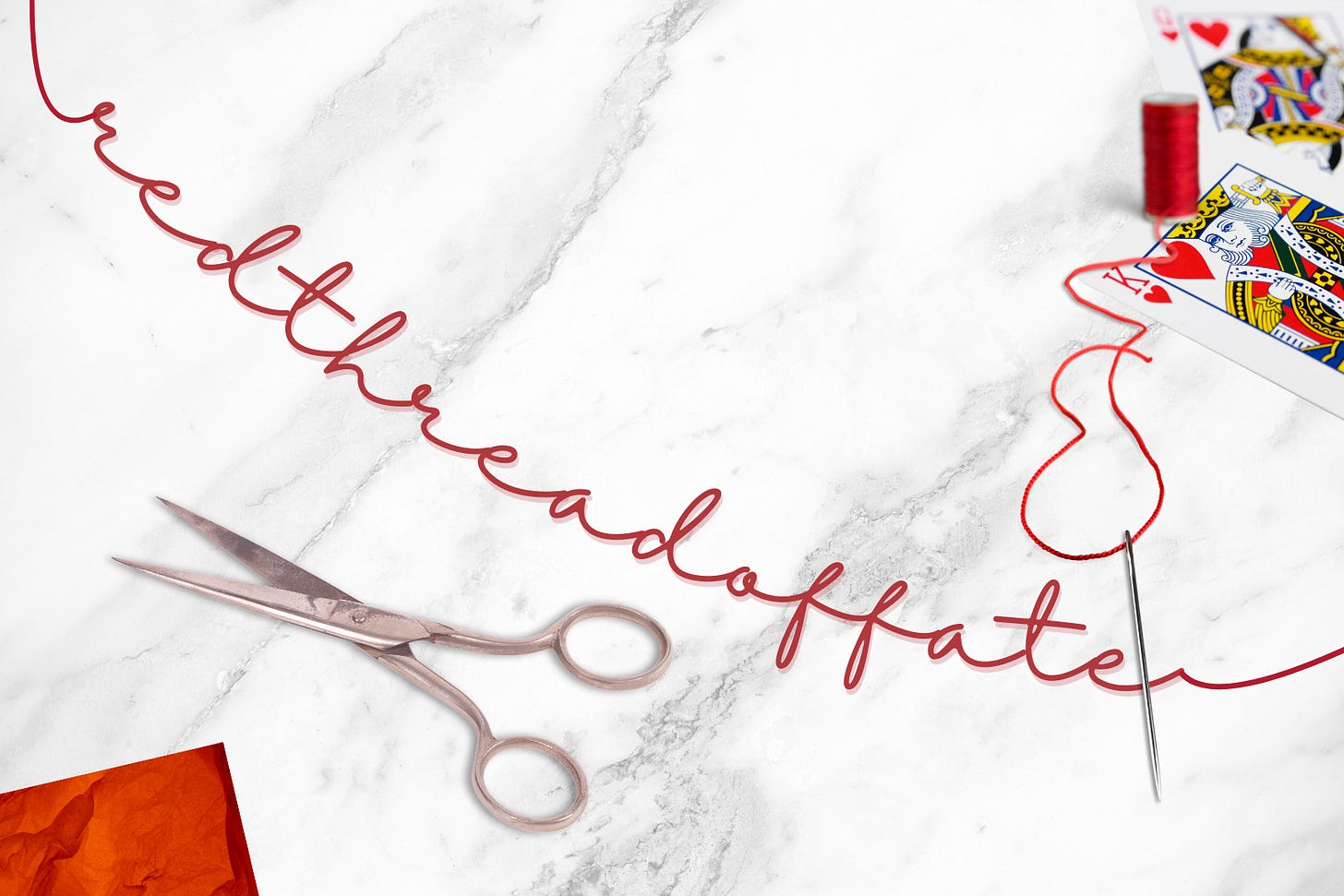🃏🌴 Packet Trick Paradise #12: Red Thread of Fate
Learn a piece of memorable magic designed specifically for couples.
Difficulty: ⭐⭐⭐ (Intermediate)
Duration: ⏱️⏱️⏱️ (7-10 minutes)
Setup Time: 🎯🎯 (Moderate)
Props: A King and Queen of Hearts, six blank-faced playing cards, red string (twine), scissors, a magic wand, and a single-hole punch or needle (with oversized eye). You may also need a thumb tip, a pull or reel and a small piece of paper.
Welcome to another edition of Packet Trick Paradise, my regular Ruseletter column where I share my boundless enthusiasm for packet tricks with the wider magic community! In this instalment, we’ll be exploring the science and symbolism of magical connection! You’ll also learn another romantic packet trick, reminiscent of “Sixpence Ceremony”, specifically designed for couples. In fact, it is the ideal trick for a bride and groom on their wedding day or for an older couple celebrating a significant wedding anniversary. 💒👰🤵
The presentation drew inspiration from “Split Soul Theory” (see Packet Trick Paradise #11) and the Red Thread of Fate. This East Asian belief states that an invisible red thread connects individuals destined to meet and fall in love. Typically tied to their fingers, wrists, or ankles, this thread symbolises the unbreakable bond between those meant to be together, regardless of time, place, or circumstance. 💞
Although the core effect is a packet trick in which two blank-faced playing cards transform into the King and Queen of Hearts, the routine begins with a brief Cut and Restored String effect to set the scene and introduce the notion of the Red Thread of Fate to your audience.
Props, Props, Everywhere!
For a packet trick, “Red Thread of Fate” employs quite a number of additional props. However, back in 2016, professional magician Joshua Jay, with considerable assistance from Dr. Lisa Grimm and The College of New Jersey, designed experiments to gather both quantitative and qualitative data on magic, magicians, and deception (see “Magic by the Numbers” in the September 2016 issue of Magic Magazine). One of the major, and truly heartbreaking, findings was that most card tricks are instantly forgettable (the study revealed that card tricks are the least memorable genre of magic). Alarmingly, only 27% of participants could describe a card trick in any detail. I’m not entirely certain which card tricks were used in the study, or whether the research participants were shown any packet tricks. However, the research suggests that any trick involving only cards is likely to be quickly forgotten by audiences!
To tackle this issue head-on, I’ve made several deliberate design choices. The research found that “people recalled card effects best when there was another prop to anchor the memory.” My first design choice was therefore to incorporate multiple non-card elements: the red string, scissors, wand, and the unusual end state of the props all contribute to making the routine more memorable, as does the symbolic connection to the Red Thread of Fate legend. The audience is left with something that extends the magical moment beyond the performance by incorporating a physical takeaway (the King and Queen of Hearts connected by the red string as a keepsake). This provides participants with a physical reminder—a tangible aide-mémoire—that helps them recall and share the experience with others.
Rather than creating just another “card trick,” I've developed what Jay would call “a trick with cards”—an important distinction that makes the overall effect significantly more memorable.
Leveraging What Audiences Love 💖
Jay’s research revealed what audiences truly value in magical performances, and I’ve designed this routine to deliver precisely that:
With 25% of respondents citing surprise as their favourite aspect of a magic trick, “Red Thread of Fate” delivers multiple surprising moments, from the mysteriously restored red string to the transformation of blank cards into the King and Queen of Hearts.
The effect also addresses an audience’s aversion to clichéd performances; 34% of respondents disliked old, repetitive, or clichéd tricks. By combining card magic with the Red Thread of Fate concept and the Cut and Restored String effect, I’ve created something fresh that audiences won’t recognise as familiar, even though it incorporates one of magic’s oldest plots!
Beyond mere trickery, the routine conveys meaningful symbolism about relationships and destiny, giving it an emotional resonance that will hopefully connect with spectators on a deeper level (according to a 2021 YouGov survey, 60% of Americans believe in the idea of soulmates).1
Jay also found that 67% of people are excited about participating in magic. This routine capitalises on that enthusiasm by making the couple active participants rather than passive observers; they are tied together by the red string and handle the cards throughout.
Finally, while Jay’s research confirmed that audiences often attribute more enjoyment to larger stage illusions, he also found that intimate magic with meaningful connections can be equally impactful. “Red Thread of Fate” creates exactly this kind of intimate yet powerful experience.
In addition, this is an excellent “transition trick” that helps you move between different types of magic in a single performance. For example, you might like to perform an extended Cut and Restored String routine with multiple phases before or after this simple packet trick. You could also substitute the string for a piece of red ribbon, allowing you to perform Troy Hooser’s modern classic “Charming Chinese Challenge” alongside (or instead of) “Red Thread of Fate”. Whether you choose to perform “Red Thread of Fate” or not, I hope you enjoy experimenting with some of these ideas.
Yours Magically,
Marty
See https://today.yougov.com/society/articles/34094-soulmates-poll-survey-data for more details.



